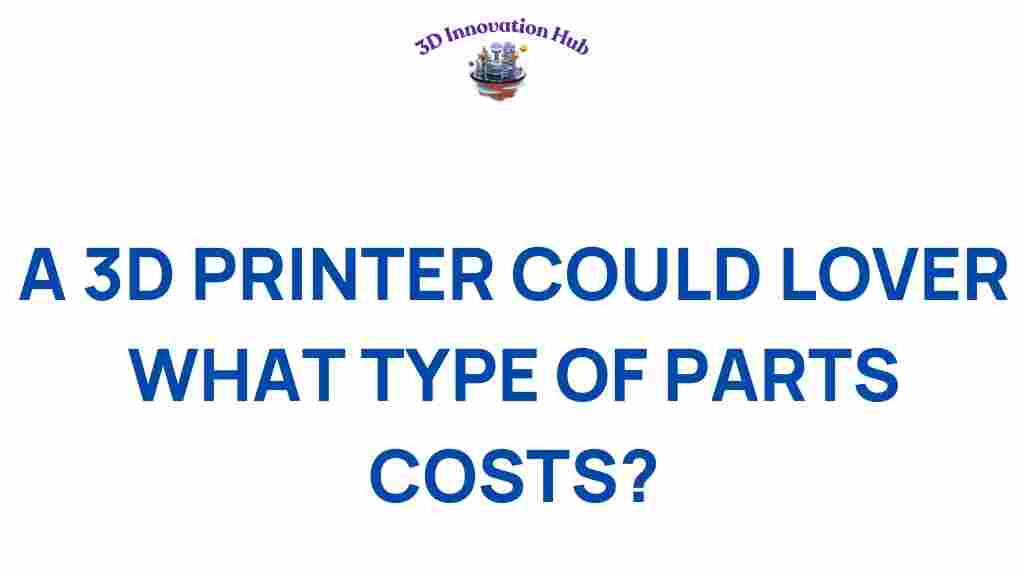How 3D Printers Could Revolutionize Parts Cost and Accessibility
The advent of 3D printers has ushered in a new era of manufacturing, drastically changing the landscape of production and supply chains. With their ability to create complex geometries at a fraction of traditional costs, 3D printers are set to revolutionize parts cost and enhance accessibility to customized products. This article delves into how this innovative technology is reshaping the manufacturing industry, addressing the challenges it solves, and providing a pathway to a more efficient future.
The Impact of 3D Printing on Parts Cost
Traditionally, manufacturing processes involve high setup costs, especially for small production runs. However, 3D printers significantly lower these costs through:
- Reduced Material Waste: Unlike subtractive manufacturing, which cuts away material, 3D printing builds objects layer by layer, minimizing waste.
- Lower Production Costs: With no need for expensive molds and tooling, 3D printers enable cost-effective production, particularly for small batches.
- On-Demand Production: Businesses can produce parts as needed, eliminating the costs associated with inventory storage and overproduction.
Understanding Manufacturing Innovation
The manufacturing sector is witnessing a wave of innovation thanks to 3D printers. Here are some key advancements:
- Material Diversity: 3D printers now utilize various materials including metals, plastics, and even bio-materials, expanding the possibilities of production.
- Speed of Production: Rapid prototyping capabilities allow businesses to develop and test products quickly, fostering faster innovation cycles.
- Complex Designs: The ability to create intricate designs that are impossible to achieve through traditional methods opens new avenues for product development.
Enhancing Accessibility Through 3D Printing
3D printers not only reduce parts cost but also improve accessibility for consumers and businesses alike. This technology democratizes manufacturing by:
- Local Production: Products can be printed on-site, reducing the need for long-distance shipping and associated costs.
- Customization: Consumers can easily customize products to meet their specific needs, enhancing user satisfaction.
- Small Business Empowerment: Entrepreneurs can leverage 3D printing to bring their ideas to life without the need for significant capital investment.
3D Printing and Supply Chain Efficiency
The traditional supply chain is often bogged down by complexities that 3D printers can simplify. Key benefits include:
- Streamlined Processes: With 3D printing, the need for multiple suppliers and logistics is reduced, allowing for a more direct supply chain.
- Real-time Production: Businesses can respond to market demands instantly, producing parts on-the-fly rather than waiting for shipments from manufacturers.
- Inventory Reduction: As products can be created on demand, companies can reduce their inventory levels, significantly cutting holding costs.
Step-by-Step Process: From Design to Production
Utilizing 3D printers in manufacturing involves several steps:
1. Design the Product
Using CAD (Computer-Aided Design) software, designers create a digital model of the product. This stage is crucial for ensuring that all specifications are met.
2. Prepare the Model for Printing
Once the design is complete, it’s converted into a format compatible with the 3D printer, typically STL or OBJ. Additional software may be used for slicing the model into layers.
3. Select the Right Material
Choosing the appropriate material is vital, as it affects the product’s durability, flexibility, and overall quality. Common materials include:
- PLA (Polylactic Acid)
- ABS (Acrylonitrile Butadiene Styrene)
- TPU (Thermoplastic Polyurethane)
- Metal powders for metal printing
4. Printing the Model
The 3D printer begins the printing process, layering material according to the digital model. This may take anywhere from a few hours to several days, depending on the complexity and size of the object.
5. Post-Processing
After printing, parts often require finishing touches, such as sanding, painting, or assembling multiple printed components.
Troubleshooting Common 3D Printing Issues
Despite the advantages, users may encounter challenges during the 3D printing process. Here are some common issues and solutions:
1. Warping
Solution: Ensure proper bed adhesion and maintain a consistent temperature. Using a heated bed can also help reduce warping.
2. Layer Separation
Solution: Check the extrusion temperature and ensure the material is being fed correctly into the printer.
3. Poor Surface Finish
Solution: Adjust the layer height and print speed, and consider post-processing techniques to improve surface quality.
Conclusion: The Future of Manufacturing with 3D Printers
In conclusion, 3D printers are transforming the landscape of manufacturing by reducing parts costs, enhancing accessibility, and streamlining the supply chain. As technology continues to evolve, we can expect further innovations that will unlock even greater potential for customization and efficiency in production.
As businesses and consumers alike embrace 3D printing, the barriers to entry in manufacturing will continue to fall, paving the way for a more sustainable and innovative future. For those looking to dive deeper into the world of 3D printing, consider exploring resources like 3D Printing Industry for the latest news and advancements.
Ready to explore the possibilities of 3D printing for your business? Visit our website for more information on how to get started!
This article is in the category and created by 3D Innovation Hub Team
